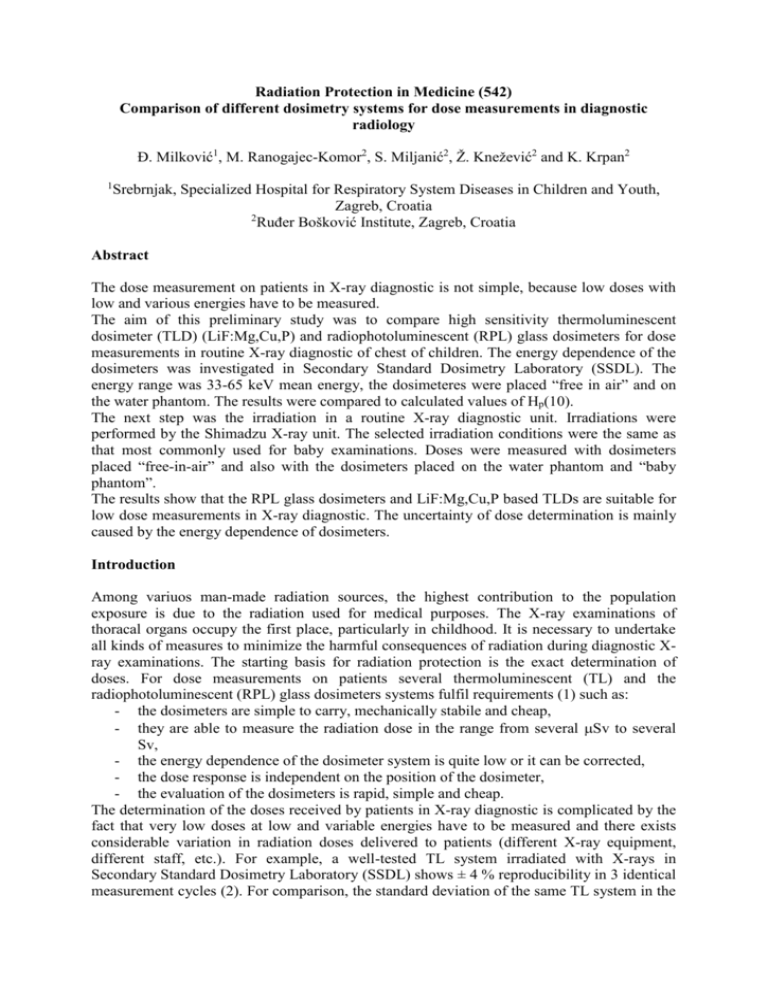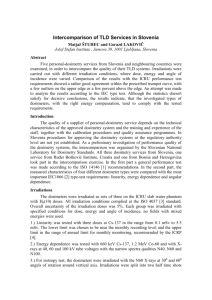Radiation Protection in Medicine (542)
advertisement

Radiation Protection in Medicine (542) Comparison of different dosimetry systems for dose measurements in diagnostic radiology Đ. Milković1, M. Ranogajec-Komor2, S. Miljanić2, Ž. Knežević2 and K. Krpan2 1 Srebrnjak, Specialized Hospital for Respiratory System Diseases in Children and Youth, Zagreb, Croatia 2 Ruđer Bošković Institute, Zagreb, Croatia Abstract The dose measurement on patients in X-ray diagnostic is not simple, because low doses with low and various energies have to be measured. The aim of this preliminary study was to compare high sensitivity thermoluminescent dosimeter (TLD) (LiF:Mg,Cu,P) and radiophotoluminescent (RPL) glass dosimeters for dose measurements in routine X-ray diagnostic of chest of children. The energy dependence of the dosimeters was investigated in Secondary Standard Dosimetry Laboratory (SSDL). The energy range was 33-65 keV mean energy, the dosimeteres were placed “free in air” and on the water phantom. The results were compared to calculated values of Hp(10). The next step was the irradiation in a routine X-ray diagnostic unit. Irradiations were performed by the Shimadzu X-ray unit. The selected irradiation conditions were the same as that most commonly used for baby examinations. Doses were measured with dosimeters placed “free-in-air” and also with the dosimeters placed on the water phantom and “baby phantom”. The results show that the RPL glass dosimeters and LiF:Mg,Cu,P based TLDs are suitable for low dose measurements in X-ray diagnostic. The uncertainty of dose determination is mainly caused by the energy dependence of dosimeters. Introduction Among variuos man-made radiation sources, the highest contribution to the population exposure is due to the radiation used for medical purposes. The X-ray examinations of thoracal organs occupy the first place, particularly in childhood. It is necessary to undertake all kinds of measures to minimize the harmful consequences of radiation during diagnostic Xray examinations. The starting basis for radiation protection is the exact determination of doses. For dose measurements on patients several thermoluminescent (TL) and the radiophotoluminescent (RPL) glass dosimeters systems fulfil requirements (1) such as: - the dosimeters are simple to carry, mechanically stabile and cheap, - they are able to measure the radiation dose in the range from several Sv to several Sv, - the energy dependence of the dosimeter system is quite low or it can be corrected, - the dose response is independent on the position of the dosimeter, - the evaluation of the dosimeters is rapid, simple and cheap. The determination of the doses received by patients in X-ray diagnostic is complicated by the fact that very low doses at low and variable energies have to be measured and there exists considerable variation in radiation doses delivered to patients (different X-ray equipment, different staff, etc.). For example, a well-tested TL system irradiated with X-rays in Secondary Standard Dosimetry Laboratory (SSDL) shows ± 4 % reproducibility in 3 identical measurement cycles (2). For comparison, the standard deviation of the same TL system in the irradiation field of an X-ray unit in a hospital without patients (±21 %) and on children patients (±100 %) during chest examination indicates the real situation (2-3). TLDs have been found to be adequate for measuring doses in X-ray diagnostic (4-5). RPL dosimeter (RPLD) is successfully used in a large scale personal monitoring, and in clinical dosimetry in Japan (6). The aim of this work was to test a new Shimadzu X-ray unit used for thorax examination of children and to compare a TL dosimetry system based on LiF:Mg,Cu,P with the RPL glass dosimetry system (FGD-200). LiF:Mg,Cu,P was chosen due to its high sensitivity, about 100 times more than TLD-100 (7). In the X-ray diagnostic of thorax of children patients very low doses are expected. Materials and Methods Some properties of the investigated dosimeters as well as some parameters used for the preirradiation annealing, preheat and readout are presented in Table 1. Table 1. The evaluation parameters of the investigated detectors Dosimeter Material Origin Size (mm) Preirradiation annealing Temperature (oC) Time (min) Preheat Temperature (oC) Time (min) Readout Temperature (oC) Time (s) RPL silver activated phosphate glass Japan (8) 15x15 TL LiF:Mg,Cu,P 400 60 210 readout cycle 70 60 100 20 UV excitation 210 35 China (9) 4.5x0.8 The RPL dosimeters consist of flat silver activated phosphate glass in a dosimeter capsule containing tin energy compensation filter. After irradiation with ionising radiation, colour centres generated in the glass during UV excitation in the reader emitt a radiation induced orange fluorescent light. In our experiments the full automatic FGD-200 Series dosimeter system with SC-1 glass dosimeters was used. The system is based on pulsed nitrogen gas UV laser excitation, which allow the electric discrimination of signals from the predose reading and the radiation induced reading. The fully automatic system (built-in calibration factors, reference glass for correction etc.) has the advantage of quick and easy reading. After irradiation the TL dosimeters based on LiF:Mg,Cu,P detectors stayed at room temperature at least one day. The reading of TL signal was carried out using a modified TOLEDO 654 (Vinten) reader. The reader is connected with a PC containing a supported software (10) which enables the integration of the glow curves with variable integration limits and a detailed analysis of glow curves. In the reader detectors were preheated at the temperature of 100oC for 6 s and then heated with a constant heating rate of 10 oC per second to the temperature Tmax (210 °C). After that the dosimeter is kept at Tmax during the time left from the readout cycle (35s). The properties of the investigated TLD as well as the parameters used for readout, were shown in our previous papers (7,11,12). For irradiation the detectors were packed in a dark polyethylene foil and placed in rubber holders. The holders with 3 mm wall thickness were used for both 137Cs and X-ray irradiations, respectively. For calibration, irradiations with 137Cs gamma ray source at the SSDL in the Ruđer Bošković Institute were performed at a distance of 1 m from the source. The dose rate was 57.51 mGy.h-1 (specified as “air kerma”, Ka). The individual sensitivity of each TL detector was previously determined by irradiation with the same 137Cs gamma ray source while the RPL detectors were calibrated individually by the manufacturer. To estimate the calibration factors 5 TL detectors placed “free in air” were irradiated with 2 mGy. For background correction 3 control dosimeters were used. The energy dependence was determined in the X-ray beams generated by a ISOVOLT 420 X Ray Unit (40-300 kV, 1-20 mA) at the same SSDL (13), with narrow spectra. The specified mean energies were obtained by varying the operating potential and added filtration. The following mean energies were used: 33 keV, 48 keV and 65 keV (40 kV-10 mA, 60 kV15 mA, and 80 kV-15mA). The irradiations were performed at a distance of 1 m from the tube. In one series the holders were placed “in air”, in the second on the “water phantom”. A plastic bottle (volume: 2.5 l) filled with water was applied as a phantom. The diameter of the bottle was 11 cm. The dose rates were 45.7 mGy.h-1, 32.3 mGy.h-1 and 42.3 mGy.h-1 at the three mean energies, respectively. The nominal irradiation dose was also 2 mGy (air kerma). The radiography irradiations were performed by 150 kV Shimadzu CH-200M unit (Kyoto, Japan) in the Hospital Srebrnjak, Zagreb. This unit is used for thorax examination of babies or newborns. The irradiation conditions were the same in all measurement cycles. The distance of the X-ray tube from the filmcasette was 150 cm. In the first measurement series one TL and one RPL dosimeter were fixed on the filmcasette in the middle of the entrance beam and irradiated in air. This step was repeated 6 time. The distance was not changed in the further irradiations, i.e. the dosimeters in the entrance beam during phantom irradiations were closer to the X-ray tube. The position of the tube, filmcasette and dosimeter on the baby doll phantom is shown in Figure 1. Figure 1. The Shimadzu CH-200M X-ray unit with the stative. The doll-phantom is located in the baby-fix. The other parameters of the irradiation were the following: the voltage of the X-ray tube was 70 kV, the quantity of charge 1.6 mAs, the time of irradiation 5 ms, the size of the focus 0.6 mm, the film format 1824 cm while the size of the irradiation beam was 15x18 cm. The irradiation conditions were chosen according the parameters used in routine examinations of babies or newborns weighting about 3 kg. Other two series of measurements were carried out with phantoms. In one series the phantom was a doll placed in the baby-fix (Figure 2). Baby-fix is a transparent plastic half cylinder. It serves for the fixation of the babies up to 1 year to prevent the movement of the baby patients. Figure 2. The position of the doll phantom in the baby-fix. After this measurement series a plastic bottle filled with water was used as a phantom. One TL dosimeter was fixed in the middle of the entrance beam together with RPL dosimeter. An other pair of TL and RPL dosimeter was located on the opposite side, i.e. in the middle of the outgoing beam. Control samples containing 3-5 dosimeters each, held at the same conditions as irradiated detectors, but not irradiated, were used for determination of background radiation. Results and Discussion Energy dependence in the irradiation field of SSDL A series of irradiations were performed “in air” and energy dependence was determined as a characteristic of the TL and RPL detector material itself. In Table 2 the experimental results of TLD and RPLD X-ray irradiations in SSDL are shown. The results are expressed as the mean values of doses measured (Dmeasured) “in air” relative to delivered doses specified as “airkerma free-in-air” (Ka). The uniformity for the RPL detectors (5 to 9 detectors) was less than 1% in SSDL irradiations at the 137Cs source, with the reproducibility in order of 1%. In the Xray field of SSDL the standard deviation (SD) of 5 dosimeters (batch uniformity) did not exceeded 1.5% in all energies. Table 2. The energy dependence of TLD and RPL detectors. Dosimeter TLD LiF:Mg,Cu,P RPL phosphate glass Dmeasured/Ka Dmeasured/Ka Mean energy (keV) a) b) 33 1.07 0.69 1.03 48 1.03 1.04 1.14 65 0.90 1.03 1.21 1.00 1.00 1.01 137 662 ( Cs) a) earlier (7) b) this work For LiF:Mg,Cu,P the energy dependence was determined earlier (2,7,12) in other SSD laboratories. The mean values of the data measured now in two measurement cycles in air show difference compared to the earlier one (Table 2). The mean values of two measurement cycles with RPLDs as a function of the energy of radiation are shown in Table 2 while in Figure 3 the energy dependence curves in each measurement cycles for both dosimeters are demonstrated. 1.4 Relative dose 1.2 1.0 0.8 0.6 0.4 0.2 0.0 0 20 40 60 80 Mean photon energy (keV) Figure 3. The energy dependence of TL and RPL dosimeters in air. : TLD; : RPLD – first measurement cycle : TLD; : RPLD – second measurement cycle Comparing the energy dependence it has to be taken into consideration that the TLDs had no filter while RPLD was placed in the badge of manufacturer (8) containing tin filter. The irradiation with 2 mGy (in air) on the 137Cs source in SSDL served for calibration of the TLDs while for RPL the calibration factor of the manufacturer in the software was used. The reason of the difference of 1% in the relative dose values after 137Cs irradiation is due to the difference of calibration at the Ruđer Bošković Institute and at manufacturer of RPL system.. Relative dose In the other series the irradiations were performed in a similar way only the detectors were placed on the plastic bottle phantom filled with water. The relative doses, i.e. the mean values of the doses measured on the phantom relative to delivered doses specified as air kerma free-in-air as a function of photon energy are shown in Figure 4. 2 1.8 1.6 1.4 1.2 1 0.8 0.6 0.4 0.2 0 0 20 40 60 80 Mean photon energy (keV) Figure 4. The relative response of TLD and RPLD as a function of the mean photon energy. : TLD : RPLD ●: Calculated values of Hp(10)/Ka (14) The shape of the curve in Figure 4 for TLD is similar to that measured in our earlier work (12) while the numerical dose values are different. The reason could be that in our earlier measurement an ISO phantom (30 cm x 30 cm x 15 cm) while now a plastic bottle water “phantom” simulating the body of a baby was used. In Figure 4 the calculated values of Hp(10)/Ka (14) are shown to demonstrate the difference in “tissue equivalence” of the detectors. LiF detector doped with Mg,Cu and P has an anomalous photon energy response compared to expected values of LiF material (1,15) and to the measured values of LiF:Mg,Ti (2,12). The reason is that the energy absorption characteristics of investigated TLDs depend not only on the effective atomic number of the TLD, but also on the influence of added dopants (7). Doses in the irradiation filed of a diagnostic X-ray unit The reproducibility of the irradiation field at the Shimadzu unit was measured in six measurement cycles three with RPLD and three with TLD. The dosimeters were irradiated in the centre of the irradiation beam fixed on the filmcasette. The mean values of three irradiation were 34.3 ± 2.1 µGy and 38.0 ± 6.2 µGy with RPLDs and TLDs, respectively. Taking into account the difference in energy dependence of the two kind of detectors, the low dose value measured and the number of measurement cycles (three) than the obtained reproducibility of 12.8% (expressed as 1 standard deviation (SD) of 6 measurements) is satisfactory. The mean value of the doses measured in six successive measurement cycles with RPL detectors and in other six cycles with TLDs on different “phantoms” are shown in Table 3. Both “phantoms” i.e. the doll and the plastic bottle filled with water were placed in the babyfix in a similar way (as in Figure 1). In every cycle the dosimeters were placed in the ingoing beam of the radiation (entrance on bottle and back on the doll) and in the outgoing beam (exit on bottle and sternum on the doll). Table 3. Mean value and standard deviation (SD) of doses measured on “phantoms” Phantom Dosimeter Place of dosimeter Mean dose (mGy) Doll (unknown plastic) RPL Bottle (water) TL RPL Back Sternum Back 0.040 0.019 0.049 0.022 SD (mGy) 0.002 0.006 0.008 SD (%) 4.3 30.6 15.5 Dentrance/Dexit 2.5 Sternum Entrance TL Exit Entrance Exit 0.041 0.004 0.030 0.002 0.007 0.002 0.001 0.006 0.004 30.0 3.9 28.2 19.5 154.9 2.3 11.3 13.0 The dose values of RPL and TL dosimeters agree well on the doll in both, entrance and exit beams. The ratio of the ingoing and outgoing beam (Dentrance/Dexit ) is about 2.5 for both dosimeters. On the water phantom this ratio is about 5 times higher and the difference between the mean values measured in the ingoing beam with the two dosimeters is quite large. One of the reason could be the different energy absorption characteristics of the two dosimeters. The doll was a phantom with not well defined material characteristics. It served for the simulation of the geometry of the patient irradiation. The energy dependence in air of the two detectors (Figure 3) is not much different at mean energies higher than 48 keV. The estimated effective energy of the irradiation at 70 kV is about 50 keV. However, using the water phantom, there is a difference between the entrance doses measured by the two dosimeters. It can be explaned by the large difference of the resposes of TL and RPL detectors at mean nominal energies below 50 keV when irradiated on water phantom (Figure 4). The water phantom simulated the backscatter of the body, which results to lower energy compared to the primary radiation. Conclusion For the risk estimation of population and for adequate radiation protection measures it is essential to determine exact doses in X-ray diagnostic treatments. TLDs offer a lot of advantage for this purpose. LiF:Mg,Cu,P TL detector has high sensitivity and in spite of its anomalous energy dependence it is nearly tissue-equivalent and was found to be a promising detector in X-ray diagnostic (2,7,12). The radiophotoluminescent glass detector was compared to this TLD. RPL system used in this work is foreseen first of all for environmental monitoring. Therefore the dosimeters are very sensitive and the filtration is constructed for the high energy radiation. The preliminary results show that the reproducibility of RPL system even in routine irradiations is about 6%. The energy dependence “in air” is better than for LiF:Mg,Cu,P in the energy range investigated (33-65 keV mean energies). On the water phantom RPL energy dependence curve changes in opposite direction than the calculated Hp(10) values, however the absolute difference from Hp(10) is not larger than for LiF:Mg,Cu,P. The measured dose values in X-ray diagnostic unit are in accordance with the characteristics found in SSDL. The RPL system seems to be suitable for dosimetric measurements in X-ray diagnostic especially taking in account that this system was developed for environmental dose measurements. Acknowledgement The authors are very grateful to Mr. Branko Vekić and Ms. Renata Ban for the SSDL irradiations in Ruđer Bošković Institute References 1. Ranogajec-Komor M: Thermoluminescence Personal and Medical Dosimetry. NATO Science Series, IV. Earth and Environmental Sciences, 41, 177-190 (2004). 2. Ranogajec-Komor M., Muhiy-Ed-Din F., Milković Đ., Vekić B.: Thermoluminescence Characteristics of Various Detectors for X-ray Diagnostic Measurements. Radiat. Prot. Dosim. 47 (1-4), 529-534 (1993). 3. Milković Đ., Ranogajec-Komor M., Krstić-Burić M., Hebrang A.: Mit Thermolumineszenz-Dosimetern gemessene Hautdosen bei ThoraxRontgenaufnahmen von Kindern und Jugendlichen. Atemw.-Lungenkrkh., 17 (1), B67-B72 (1991). 4. Vekić B., Ranogajec-Komor M.: Determination of Patient Surface Doses from Computerized Tomography Examinations of the Head. Radiat. Prot. Dosim. 66 (1-4), 311-314 (1996). 5. Ranogajec-Komor M., Nikodemová D., Horváthová M., Knežević Ž., Milković Đ.: Radiation Exsposure of Children during Radiognostic Examination of Chest, Proc. of the IRPA Regional Symp: Radiation Protection in Neighbouring Countries of Central Europe, Prague, 8-12. 09. 1997. Ed. Sabol J., Czech Technical University, Prague, 298-300 (1997). 6. http://www.c-technol.co.jp/technol_eng/ 7. Miljanić, S., Ranogajec-Komor, M., Knežević, Ž. and Vekić, B. Main Dosimetric Characteristics of Some “Tissue-equivalent” TL detectors. Radiat. Prot. Dosim. 100(14), 437-442 (2002). 8. http://www.agc.co.jp/english/company/agc.html 9. Zha Z., Wang S., Shen W., Zhu J., Cai : Preparation and Characteristics of LiF:Mg,Cu,P Thermoluminescent Material, Radiat. Prot. Dosim. 47(1-4), 11-118 (1993). 10. Knežević Ž., Krpan K., Ranogajec-Komor M., Miljanić S., Vekić B., Rupnik Z.: Interface and Software Development for Thermoluminescent Dosimetry. Proc. of 6th Symposium of the Croatian Radiation Protection Association (CRPA), Stubičke Toplice, Croatia, 18-20. 04.2005. Eds: Garaj Vrhovac V., Kopjar N., Miljanić S., CRPA, Zagreb, Croatia, 111-116 (2005). 11. Knežević, Ž., Miljanić, S., Ranogajec-Komor, M., Vekić, B., Štuhec, M., Lakovič, G. and Martinčič, R. Response of New TLDs to Medium and Low Energy X-rays In: CDROM Proc. of IRPA Regional Congress on Radiation Protection in Central Europe "Radiation Protection and Health", Dubrovnik, Croatia, 20-25. 05. 2001. Eds. Obelić B., Ranogajec-Komor M., Miljanić S. and Krajcar Bronić I.. CRPA, Zagreb, Croatia, Paper no. 7p-09 (2002). 12. Miljanić S., Knežević Ž., Štuhec M., Ranogajec-Komor M., Krpan K., Vekić B.: Energy Dependence of New TLDs in Terms of HP(10) Values. Radiat. Prot. Dosim. 106(3), 253-256 (2003). 13. Vekić B., Ban R., Miljanić S.: Secondary Standard Dosimetry Laboratory at the Ruđer Bošković Institute, Zagreb. Proc. of 6th Symposium of the Croatian Radiation Protection Association (CRPA), Stubičke Toplice, Croatia 18-20. 04.2005. Eds: Garaj Vrhovac V., Kopjar N., Miljanić S., CRPA, Zagreb, Croatia, 40-48 (2005). 14. International Standard Organization: X and Gamma Reference Radiation for Calibrating Dosemeters and Doserate Meters and for Determining their Response as a Function of Photon Energy – Part 3: Calibration of Area and Personal Dosemeters and the Measurements of their Response as a Function of Energy and Angle of Incidence. ISO 4037-3 (Geneve, Switzerland: ISO) (1999). 15. Uchrin G., Ranogajec-Komor M.: Thermoluminescence Dosimetry, in Ionizing Radiation: Protection and Dosimetry, ed. G. Paić, CRC Press, 123-156 (1988).






